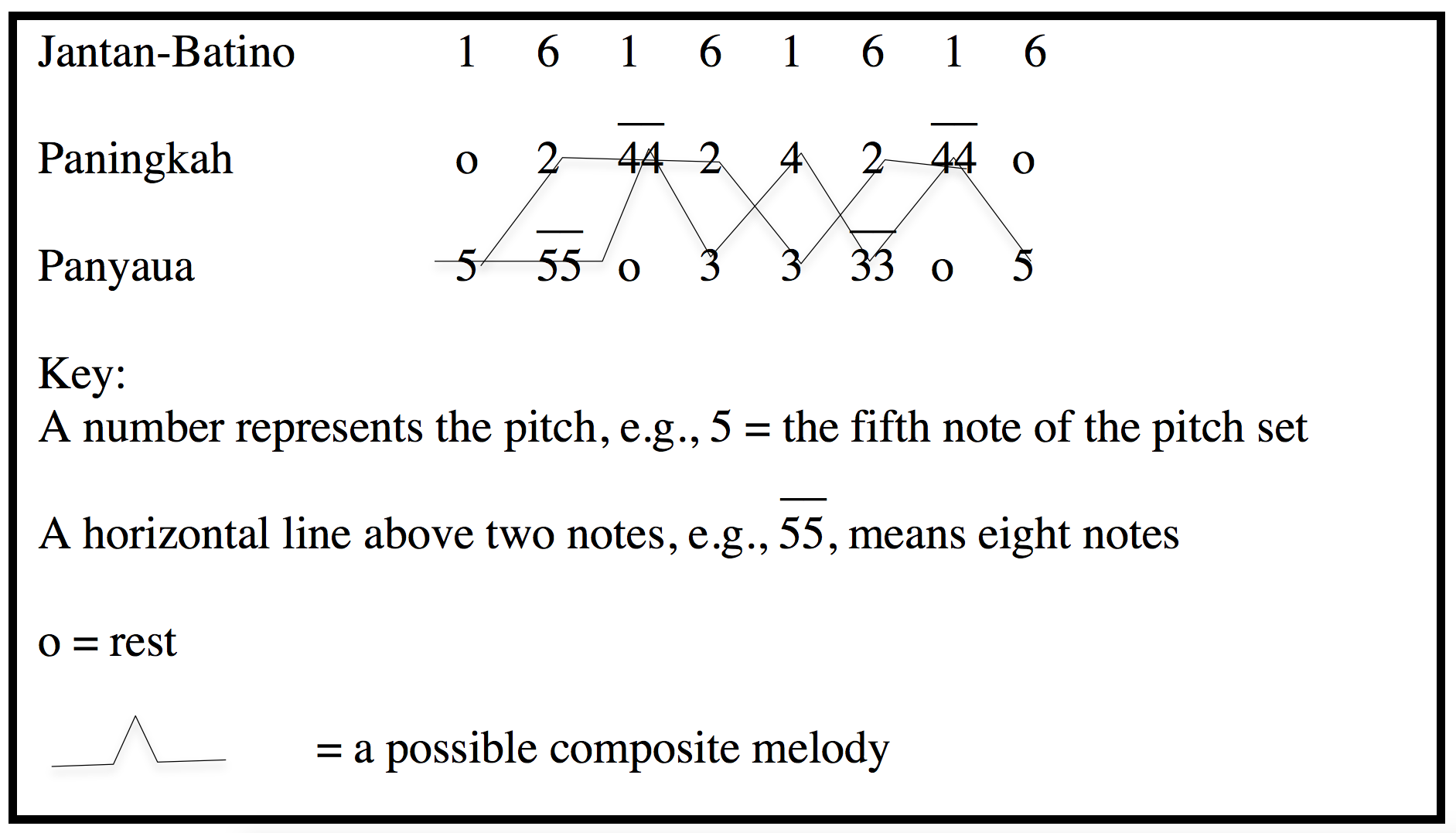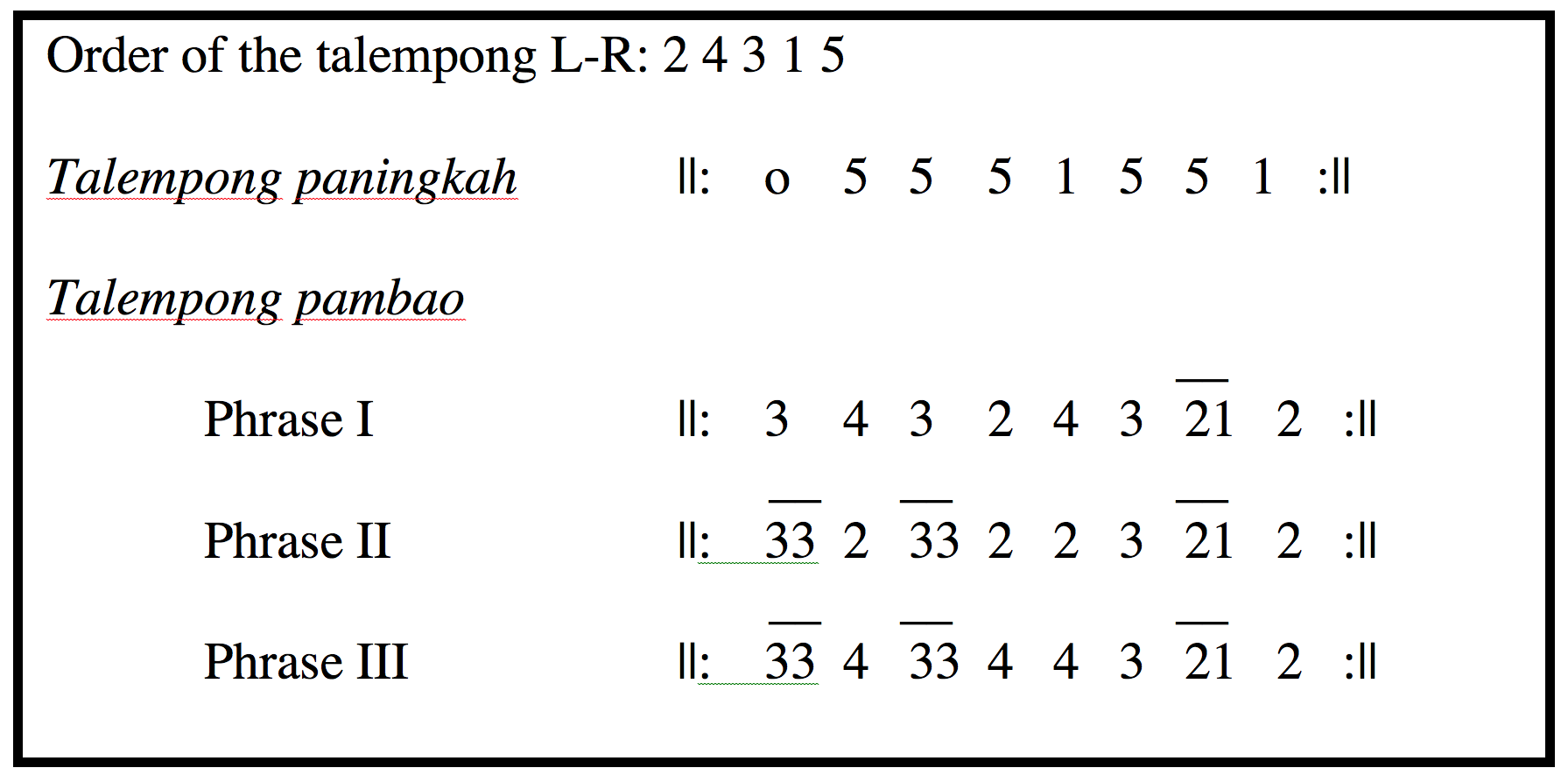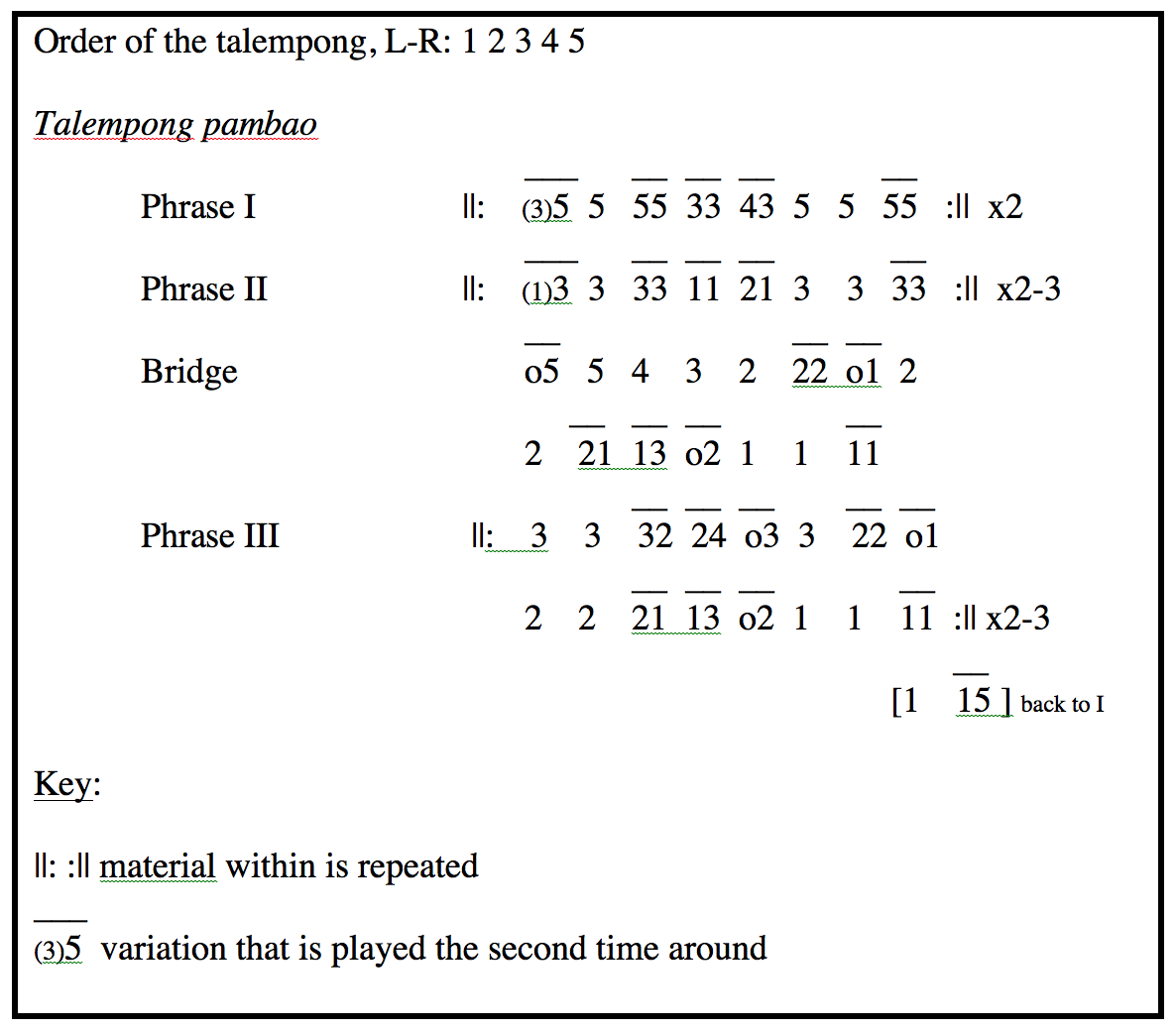The Sustainability and Evolution of Talempong: Pluralism in Minangkabau Gong Practices
Abstract
This paper has as its focus the evolution and current sustainability of talempong (Minangkabau kettle gong ensembles) in the twentieth and twenty-first century. Previously published work devoted to the analysis of talempong music and development of new styles is limited. Drawing on my own ethnographic research over sixteen years, and supplemented with archival recordings and photographs generously shared by Margaret Kartomi, I briefly sketch out the history of talempong over the last sixty years. The main focus of the paper, however, is on the aesthetics of village styles and the sustainability of talempong in several villages today, including the ways they have adapted (or not) to the demands of the times. I am particularly interested in transmission methods, contrasting long-term exposure and imitation employed in village contexts with pedagogical approaches employed at institutions that involve more explicit models, such as notation, analysis, and new epistemologies.
An Overview of Talempong
Among the Minangkabau, the people who populate the province of West Sumatra and have migrated throughout the Indonesian archipelago, the primary music involving gongs is called talempong.1 Typically, when the term is used in reference to an instrument, it denotes a small, bossed kettle gong made from bronze, or more frequently these days a cheaper alloy, such as brass, that is about seven inches in diameter. These individual gongs are tuned and arranged into gong-chimes. The number of kettle gongs and the way they are tuned, used, and combined with other instruments, such as winds, drums, hanging gongs, and other percussion, are indicative of the style. We do not know exactly how old talempong is; certainly it follows the arrival of bronze culture in Sumatra, which Margaret Kartomi suggests is around 1000 to 500 BCE (Kartomi 2012:147). In another article, she suggests talempong is among the genres that predate the arrival of Islam in Sumatra at the end of the thirteenth century (Kartomi 1998:600, 608).
While it is impossible to know what was played in the villages of West Sumatra a hundred years ago, a clearer historical record exists for the last sixty years or so, when the number of talempong styles expanded. The newer styles bring with them aesthetic frames that radically differ from their antecedents. For example, sixty years ago talempong ensembles involved from four to seven people. There were two primary styles: the first featured melodies played on the kettle gongs (video 1); the other included a dynamic weave of melodically and rhythmically interlocking talempong parts (video 2).
Video 1. “Ratok Mandeh,” talempong duduak ensemble in Paninjauan, January 18, 2014.
Video 2. “Taktuntun Ampek,” talempong pacik ensemble in Padang Alai, March 17, 2004.
Both styles presented rhythmic grooves that were established by supporting instruments and cyclical forms. The tuning was non-diatonic and varied from one village to the next, as did instrumentation, names of the parts, playing techniques, tunes, and gender associations of the players. While these two styles continue to exist today, they are indicative of an older layer of practice.
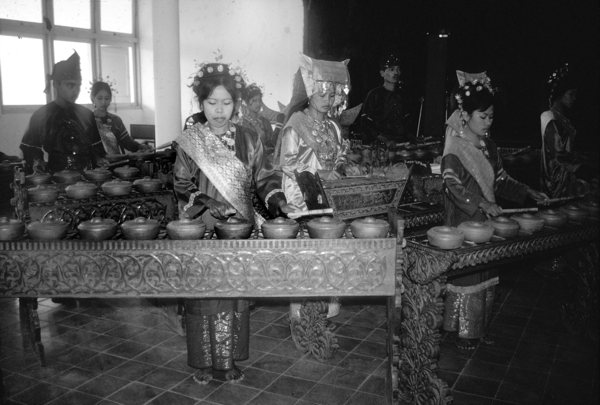
The expansion of talempong styles had much to do with the founding of an institution for the arts in the highland town of Padang Panjang in 1965. Best known as Akademi Seni Karawitan Indonesia (ASKI, often translated as the Academy of Traditional Indonesian Arts, the name it held for more than thirty years), the institution is now known as Institut Seni Indonesia (ISI, Institute of Indonesian Arts), Padang Panjang, for the town in which it is located. If you were to visit the institution in the early 1970s, as Margaret Kartomi did, you might have encountered a talempong ensemble that was significantly expanded from the five to seven to include approximately seventeen people (fig. 1). Here, in a form called orkes talempong (talempong orchestra), the talempong were tuned diatonically and were used to play melodies accompanied by functional harmony. The pieces were highly sectional in form (audio 1).
Orkes Talempong, “Tari Barabah,” ASKI, Padang Panjang, 1972. Recording by Margaret Kartomi. Used with permission.
Video 3. “Malam Bainai,” talempong goyang, Alfa Musik, Padang Panjang, June 17, 2010.
While I am interested in the general evolution of talempong styles in the twentieth and twenty-first century, my primary focus here is on the current sustainability of village styles. This is not to say that I am a preservationist arguing that these styles are inherently more valuable than the newer styles—it is, after all, the nature of music to change, and every style has value to the people who make, listen, and otherwise engage with it—but rather I am interested in tracking and discussing how these village styles have responded to shifts in social, political, and musical values, along with what the future might hold for them. In order to tell the story of talempong’s evolution, it is necessary to discuss the role of the Institute in teaching these village styles and in developing new talempong orchestras (see fig. 1). I myself am a product of this institution, a Dharmasiswa2 student in 1998 and 1999. My first engagement with playing talempong was there, and some of the tunes I teach in my village-style talempong ensemble at Oberlin College today are the tunes I learned in the talempong tradisi (traditional talempong) class. Ironically, those particular tunes now exist purely in institutional contexts, as the practice has died out in Sialang, the village where they originated. Not all talempong practices in the villages have suffered the same fate. Some villages have vibrant practices. Comparing transmission practices at the institution with those in the villages sheds light on differences in the processes, such as between implicit and explicit forms of knowledge (Perlman 2004). Compared to its more famed gong ensemble cousins in Java and Bali, talempong has received little international scholarly attention. In the United States, Australia, and Canada, musicians and scholars, myself included, often first encounter musics of Indonesia through Central Javanese or Balinese gamelan. After they fall in love with it, they rarely make it farther afield into the incredibly diverse wealth of practices in other parts of the archipelago. The constitution of this volume is indicative of this trend. There are a few important exceptions, however, the most important of which is perhaps the Music of Indonesia series, a twenty CD set edited by Philip Yampolsky that exposes the richness of instrumental and vocal music throughout the archipelago and yet completely avoids well-known gamelan practices (1991–2000). The series, especially Gongs and Vocal Music from Sumatra (volume 12), is largely responsible for stimulating my interest in the musical world beyond gamelan (Yampolsky 1991). The work of Margaret Kartomi (Kartomi 2012) and Julia Byl (Byl 2014) in Sumatra, Andy Sutton (Sutton 2002) in Sulawesi, Sean Williams (Williams 2001) in Sunda, and Nicholas Gray (Gray 2011) on gender wayang in Bali has collectively done much to expand the literature beyond the gamelan traditions of Java and Bali, as has recent work on Islamic and/or popular musics (Harnish and Rasmussen 2011; Rasmussen 2010; Wallach 2008; Weintraub 2010).
Given the considerable cultural diversity of the Indonesian population with more than three hundred recognized ethnic groups, we still know very little about the musical practices from much of the country. The English-language literature dealing with talempong, like most Minangkabau musics and other regional practices, is limited. Kartomi briefly discusses village styles of talempong in a number of articles (Kartomi 1979; Kartomi 1998) and in her recent monograph (Kartomi 2012), while David Salisbury, originally her student, completed a dissertation on talempong (Salisbury 2000) that was subsequently published (Salisbury 2009). My book, Gongs and Pop Songs: Sounding Minangkabau in Indonesia (Fraser 2015), is the first to chronicle the history and variety of talempong styles. While related to this broader work, this chapter puts the focus on processes of transmitting village-style talempong and questions of its continuity and sustainability in the twenty-first century.
Village-style Talempong

The two main styles of talempong found in the villages today take their names from the function of the ensemble. In talempong pacik (fig. 2), the set of five or six talempong are pacik (held) in the hands of performers. The form is mobile and is primarily used for processions in weddings and other kinds of ceremonies, such as the installation of a lineage chief. In talempong duduak (fig. 3), in contrast, the performers are seated, as the term duduak (to sit) indicates. Depending on the village, the set of five to seven talempong are mounted on a low wooden frame, with one or two performers seated behind it. These sedentary ensembles play music on site for weddings, other life-cycle ceremonies, communal work parties, and sporting events. Arzul Jamaan, my host father, offered the theory that talempong pacik was older because it was more logical that people held the talempong to play them before they started arranging them on a stand (personal communication, July 26, 2010).
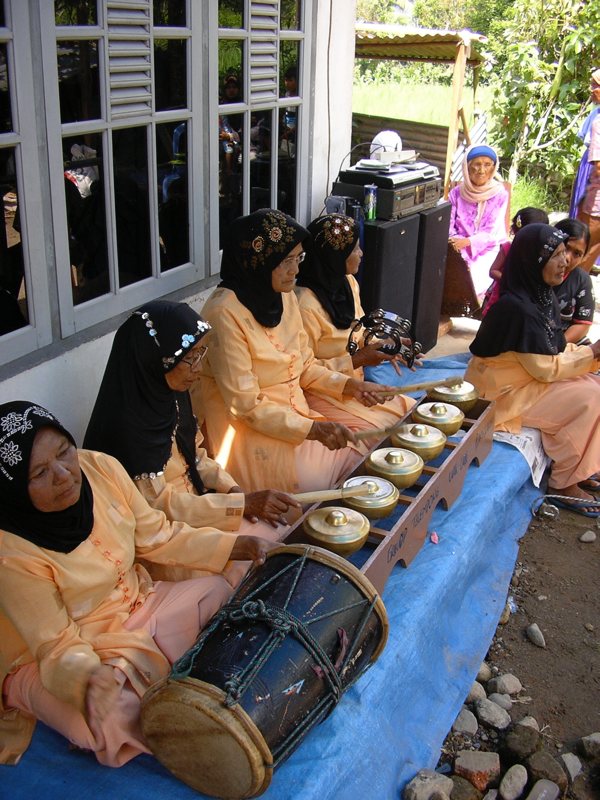
In talempong pacik, the more frequently encountered style, the talempong are divided among performers, so each person holds one or two gongs. Each part involves a pitched pattern that repeats. In village contexts, performers typically do not theorize the music, thus they do not articulate the number of beats per cycle. In any given piece, the parts are aligned in such a way that interlocking takes place between the parts, meaning the rhythms and pitches of one part fit between the spaces of another. When the paningkah part rests, the panyaua part plays, and vice versa (see music example 1). There is also a distribution of what is represented here as the eighth notes, so only eighth notes are in one part at a time. A denser, composite melody results from the interlocking, though differences are likely in the way performers and listeners cognitively process that result. I have marked two composite melodies, although many other permutations are possible.

The names of the parts, which vary between villages, sometimes refer to the function of the part. For example, in Padang Alai, a part is called the saua (interlocking), while in Bungo Tanjueng a part is termed the panyaua (the interlocker), a word that adds a prefix to the root of saua. In Padang Alai, the other parts are called the polong (channel), the tingkah (elevator), and the aguang (gong), a name that suggests the part was once played on a larger gong. Using numbers to refer to the order of the pitch set from lowest to highest, rather than referring to scale degree or intervallic structure, the parts divided up the set as aguang (pitch 1), polong (pitches 3 and 5), saua (pitches 2 and 4), and tingkah (pitch 6, which is an octave above the aguang). In Bungo Tanjueng, a set of six talempong is also used, though there are some inconsistencies about naming the parts. The standard used by Elizar, a faculty member from this village, in teaching this style at ISI is jantan-batino (refers respectively to a rooster and a chicken, and covers pitches 1 and 6, sometimes one or the other depending on the piece); paningkah (a termed derived from tingkah and covers pitches 2 and 4); and panyaua (pitches 3 and 5). Although Padang Alai uses four talempong parts, it is more typical, however, to have three parts.
The final dimension to discuss relative to the structure of talempong parts in pacik pieces is that not all parts are static. Some parts—for example, the panyaua and paningkah in Bungo Tanjueng—are expected to vary over the course of a performance. When varying, the ideal is to keep the rhythmic feel similar but to play with pitch (e.g., flipping the placement of the 2s and the 4s) by taking and expanding a fragment, inserting more density, or adding more syncopation. At least one part in a talempong pacik ensemble, in this case, the jantan-batino, remains constant, providing a point of reference for those that vary. This means the composite is a dynamic weave of talempong parts in which the syncopation and rhythmic density are constantly shifting, thus affecting the nature of the interlocking. The first music example (music 1), then, offers more of a theoretical possibility of interlocking and composite melodies than a descriptive account of a particular performance of the piece.
In my description of the music thus far, I have focused exclusively on the talempong parts, even though additional instruments are included in talempong pacik ensembles. Percussion instruments, like drums and larger gongs, provide a time-keeping function. In Bungo Tanjueng and other villages, a melodic wind instrument, such as the pupuik batang padi (rice stalk aerophone), is added to the mix. This melody is layered on top of the weave of talempong parts and is often only tangentially related to the composite contour. While these additional instruments contribute an important dimension to the overall aesthetic, the interweaving of talempong parts is at the core of this music.

If the emphasis in talempong pacik is on the melodic-rhythmic interweave of parts, in talempong duduak it is on the melodies played by the lead talempong part. Typically, the melody part features a series of eight- or sixteen-beat phrases that are structured in larger cycles. For example, the piece “Urang Halaban Batimbang Baju” has three phrases in the melody part, called talempong pambao (the bringer of the melody), and in the interlocking talempong paningkah part (musical example 2 and audio 2).
Talempong duduak tune from Unggan, “Urang Halaban Batimbang Baju,” performed on December 30, 2003.
When performed, each phrase is repeated a few times before moving on to the next one and cycling back to the beginning. While “Urang Halaban” is straightforward in structure, other pieces are more complex. For example, a piece from Sialang called “Timbang Baju” has an opening phrase, five phrases, two bridges, and a closing phrase. Each phrase may be repeated, but the bridges are played only once. In performance the piece begins with the opening phrase, cycles between Phrases I through IV, Bridge I, Phrase V, Bridge II, and back to Phrase I until the performer decides to play the closing phrase. In Paninjauan, the cycles are less linear in progression, often moving from Phrase I to II to III and back to II before moving back to I, as in the pieces “Tupai Bagaluik” (see Fraser 2015) and “Ratok Mandeh” (see video 1). Like talempong pacik, these talempong duduak pieces are open-ended. There is no set number of times in which the cycle is repeated, rather the timing is adjusted according to the needs of the occasion. Musicians may play a particular tune anywhere from a few to twenty minutes. The repetitive nature of this music, as we shall see, is key to learning.
Depending on the village, there may or may not be a second talempong part in a talempong duduak ensemble, typically called the talempong paningkah, which interlocks with the melody. While the melody part typically features a series of phrases, the paningkah part is an ostinato that never varies. These melodies are backed by ostinati and rhythmic grooves set up by other percussion instruments, though the instrumentation varies between villages, including one or two larger hanging gongs, one or two double-headed drums, frame drums, tambourine, and bottle. Again, I have focused on the talempong parts in this discussion because these are key to the form.
The gender associations of talempong practices vary from village to village. While pacik is mostly a male practice, women play in some villages, such as Unggan and Padang Alai. With talempong duduak the reverse is true, though the only male duduak tradition I know of—in Sialang—is no longer practiced. In the discussion of the transmission process that follows, all of the ethnographic data comes from villages where women play. This is not to say that men do not play—quite the contrary with regard to talempong pacik—but rather it reflects the contingencies of my fieldwork.
The Transmission of Village-style Talempong
Immersion is key to learning talempong in village contexts. Many of the women with whom I worked were exposed to talempong because their mothers or grandmothers played. Accompanying their mothers to ceremonies that lasted for hours and sometimes days on end, they heard the same tunes over and over. The relatively restricted content of duduak tunes—three to five phrases—and cyclical structure of the music further helped facilitate learning. In his 2004 book on implicit melody concepts in Central Javanese gamelan, Marc Perlman uses the work of psychologists and anthropologists to distinguish between implicit and explicit forms of knowledge, the former unverbalized, the latter verbalized. One productive application of these concepts is to the process of learning music. Just as knowledge about gamelan is learned implicitly in some contexts “by watching and imitating” (Perlman 2004:22), so talempong is often learned in village contexts. It is primarily a tacit process. Some of the women, including Siti Aisah, Asnamawarti, and Hendrilisna in Unggan, had started learning at a very early age, when they were just five or six years old. Other women, such as Nurlaili in Unggan, Yusni in Paninjauan, and Asma in Padang Alai, were a little older, around ten years old or in their teens. Mardiani and Asma in Paninjauan started playing talempong later in life, often after they had already raised a family. Many of the women who learned in their youth had a mother or grandmother who was a talempong musician, which increased a girl’s exposure to the music. As Ranti explained to me, if one’s mother has a jiwa seni (artistic spirit), this will surely have passed on to the children. In other words, for her, playing talempong was in her blood, just as it was for her mother, Asma, who learned from her own mother (personal interview, March 18, 2004). It was actually more uncommon that someone learned talempong without that familial connection, but Hendrilisna was fascinated and studied with Yulinar, the mother of her friend Asnamawarti.
Most of the women talked about an immersive learning experience. They would watch and listen, then test it out for themselves, either at home or when the performers were taking a break at a ceremony. Knowledge was conveyed tacitly. Sometimes, however, someone was on hand to correct them and to give them verbal guidance. Thus, learning ideally involved a bit of implicit and explicit knowledge. Unggan, however, was the only location I know in which students formally studied with a teacher. My teacher, Siti Aisah, told me of tawa, an initiation ceremony that formalizes the relationship between student and teacher. I underwent that ceremony myself on my first night in Unggan in November 2003. Most of the other women I talked with in Unggan had not gone through tawa. Instead, they all related how they learned on talempong kayu (a xylophone with moveable slats), a cheaper and therefore more accessible instrument than the kettle gongs. In 2003 and 2004, many of the young girls were learning on a talempong jao (Javanese talempong), so called because the instrument resembles a saron with the keys being made from metal, but in this case it was usually an old oil can. When learning the tunes, they sang them to themselves or played them, as Siti Aisah did, on a rubber genggong (jew’s harp).
These talempong performers always talked about learning the talempong parts before learning any of the other instruments in the ensemble. This is in part because the talempong are the featured instruments but also because the talempong parts, whether in duduak or pacik, are more difficult than the supporting instruments, which often do not need explicit instruction. Asnamawarti, for example, said she did not need to study the gong part: she just knew it. The emphasis on learning talempong first before the gong and drum parts was certainly true in Unggan and Padang Alai. In Unggan, several of the women talked about trying out the various parts of the ensemble on makeshift instruments. For example, Nurlaili used a bucket for the gong and an oil can for the drum when she was learning at home. Siti Aisah likewise used a cake tin for the gong. I myself witnessed a plastic washtub and metal cookie container used for the gong and a plastic cookie container for the drum. They often began performing at ceremonies by playing one of these easier parts before taking a turn at the talempong. In Unggan, it is quite typical in practice that the women do not specialize in one instrument but move around from one part to the next. Interestingly, in Paninjauan, the women never talked about learning the other parts at all, but in my experience there over the last ten years, the women did not tend to move around as much. Only a few women could play the melody parts.
In Padang Alai, learning talempong pacik entailed knowing all four talempong parts for one tune at a time before moving on to the next tune. The hardest parts were those with two talempong, the polong and saua. The ability to vary came later, after basic knowledge was established. When I asked why it was important to cover all the parts, Ranti said it was because they traded them off. Knowing all the parts strengthens understanding of the part you play. Moreover, learning as a group is integral. I wanted to learn the pacik practice there, but I could not because I did not have any friends with whom I could learn.
The Sustainability of Village-style Talempong
It is my contention that the sustainability of these talempong practices is tied up with changes to transmission practices, which have changed over the years in concert with social conditions. Most significantly, children attend school longer and women are active in the workplace. The younger generation no longer has the luxury of time to learn talempong in the way their mothers and grandmothers did. To master tunes in talempong duduak is a time-intensive process. When I was interviewing Asma and Rosani, members of the Paninjauan ensemble, Asma’s nineteen-year-old granddaughter Elsi, who was a college student in the nearby town of Bukittinggi, was listening. At one point she joined the conversation, saying that girls had more time to learn in the past, when they were sitting around in the rumah gadang (a Minangkabau longhouse for a woman and her daughters) before they were married. Now girls the same age have lots of activities outside the house, such as school and extracurricular activities (personal conversation, July 24, 2010).
If they had started playing talempong as young girls, raising children often forced women to take a hiatus, as thirty-two-year-old Ranti explained to me. Being out of the house, sometimes in the evenings, to play talempong was problematic (personal interview, March 18, 2004). Childcare duties, cooking, and other housework fall largely to women in West Sumatra today. Women with young children simply do not have the time to learn or play. Women who might have picked it up again or learned later in life when their children were old enough were now often busy working outside the house to earn income and to meet the increasing economic pressures on nuclear families and the demands for economic capital.
Over the years I have heard other rationales about why the younger generation is less interested in learning, ranging from “it’s behind the times” to “it’s too hard.” Younger people prefer the newer talempong styles with diatonic tuning that they encounter at school. The girls claim they are easier to learn, which is probably true, but what does this mean for the long-term sustainability of talempong practices in the villages? In some places where I worked, the primary—and often only—musicians were women aged sixty to eighty years old. They joked that if younger people wanted to learn, they would have to come learn from me some day. When I returned to Paninjauan in January 2014 with a group of students from Oberlin College, it was heartening to see young girls practicing,3 although at that time they had learned just two of twenty or so tunes in the repertoire.
Concerns about the vitality and viability of these older styles, however, have been addressed in Unggan and other villages by a willingness to incorporate new material, such as pop songs and dendang (tunes from the dominant Minangkabau vocal genre, saluang jo dendang). While the adaption of these tunes to talempong has often necessitated a shift toward the diatonic tuning of the instruments, the structure of the music continues to emphasize the melodic-rhythmic grooves and repetitive cycles. When these songs are adapted to talempong pacik ensembles, the melodies are divided between players in a hocketing fashion. So while the resultant product maintains the technique where several performers are each responsible for one or two gongs, each performer plays only when her pitch is required in the melody, rather than playing a given melodic-rhythmic groove continuously. The aesthetic changes are less drastic in talempong duduak, though none of these pieces has the interlocking talempong paningkah part.
When I was working in Unggan in 2003 and 2004, the repertoire was quite extensive and included a series of twelve or so older tunes and more than twenty new tunes. With so much new material, a capable performer did not always know the name of the tune her friend played. Nurlaili provided some insight into the origins of these tunes when she commented, “Whatever the song is on the CD, I try it on the talempong. I can do it” (personal interview, December 30, 2003). Rather than learning from CDs, however, I suspect she meant VCD (video compact disc),4 as the technology for VCDs was cheaper and thus more available than that of CDs, a format I rarely encountered in West Sumatra in the early 2000s.
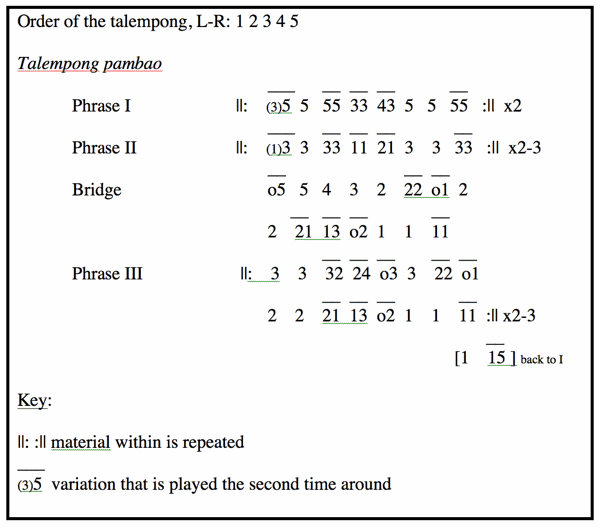
In Unggan in 2003 and 2004, the younger girls were actively learning, but they were interested in the new tunes, nan di laguan (those that could be sung). Nurlaili, for instance, said her granddaughter had been learning from her and already had five songs. All five of them were the new tunes. When I asked why she did not learn the old tunes, Nurlaili recounted, “She doesn’t want to. . . . It’s difficult.” In fact, the women there recalled how they started teaching with these newer tunes, such as “Sijunjuang Lansek Manih” (a song about a sweet longan, a fruit related to lychee [audio 3]) and “Oto APD” (a song about a bus company). Asnamawarti related how she used “Lansek Manih” first, because it is easy and the tune is short (music 3 and audio 3), before moving on to longer tunes. It was the first tune I learned myself, and part of my lessons included learning to sing it as a song (audio 4).
“Sijunjuang Lansek Manih,” Siti Aisah, playing on talempong jao in Unggan, November 29, 2003.
The tune of “Sijunjuang Lansek Manih,” the author’s talempong lesson with Siti Aisahi in Unggan, November 29, 2003.
In Sialang and other villages, the local style of talempong has died out. In Paninjauan and elsewhere, its survival is precarious. Even though young girls have started learning, they know very little repertoire. It is likely much will be lost when Yusni, the repository of that knowledge, passes on. In Unggan, however, the practice seems to be morphing, with the younger generation learning the new tunes. In Padang Alai, it seemed like the trade-off involved an expansion of gender associations. The pacik practice has historically been gendered female, but in 2004 Asma related how boys had started learning it in middle and high school, occasionally even playing at ceremonies. In her opinion, it was better to have men play than to have the practice be lost entirely. When I returned to Padang Alai in 2014, I learned that the next generation of women had taken over the practice.
In summary, there has been a significant lifestyle shift in terms of women’s increased participation in state educational opportunities and the workforce. These changes have had serious consequences on and for the continuity of talempong. In some villages, the talempong practice is adjusting to the times; in others its continuity is threatened or it is already extinct. Some conditions outside the village contexts have contributed to this shift.
Institutionalization of the Arts and the Emergence of New Styles
In 1965 an institution for the arts was established in Padang Panjang to preserve and develop indigenous Minangkabau practices.5 The only institution of its kind outside Java and Bali, the institution, now known as ISI, introduced new ways of shaping, thinking about, framing, teaching, and disseminating Minangkabau music, including new approaches to talempong. The village styles I discuss here were incorporated into the curriculum. When I took this class as an exchange student at ISI in 1998 and observed it again in 2004, the transmission methods were radically different than they were in the villages. Firstly, it should be noted that the people who now teach these classes are products of the institutional system. They are not artists from village contexts. Secondly, the pedagogical model involves explicit, rather than implicit, knowledge through the use of notation, analysis, and theoretical language, thereby helping to revise epistemologies—different ways of knowing—for the same practices. The new pedagogical methods have also encouraged increased competencies—fluency, for example, with reading notation and replicating pieces precisely—while arguably diminishing others (Brinner 1995; Perlman 2004).
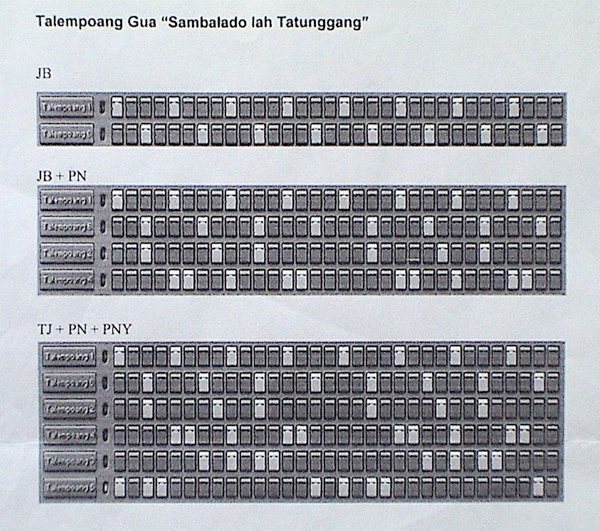
To clarify the differences in approach, let me focus on the talempong pacik component of the class where Elizar provided the students with two kinds of notation: one akin to the Time Unit Box System (TUBS), where each pulse is represented by a box, each pitch by a separate line (fig. 4), and cipher notation (fig. 5 for the piece “Gua Sambalado lah Tatunggang” used in music 1). Much like learning talempong pacik in Padang Alai, Elizar made sure the students knew the basic talempong parts for each piece before moving on to teaching the principles of variation. The greatest difference from learning in a village context was the use of notation and the explicit, verbalized instructions about how the students should go about varying their parts. Without these variations, Elizar told his students, the music would be boring. He provided students with notated models of the variations and then demonstrated what he isolated as three different kinds of variation. It is unlikely that in the village the musicians were able, or needed, to articulate different variation techniques as thoroughly as he did. They simply learn through imitation and by practice. In other words, what was an implicit form of knowledge in indigenous contexts became an explicit form in institutional ones, including a vocabulary to refer to different strategies of variation. Elsewhere, I argue that the formalized systems of learning in place at ISI engender the creation of new practices that are parallel to, but ultimately distinct from, village experiences (Fraser 2015).

Arguably, the greatest consequence of institutional engagement with talempong, however, has been the development of new styles. The diatonic talempong idiom that originated in orkes talempong (audio 1) has irrevocably changed the contours of the Minangkabau musical landscape. The talempong style is dominant in the curriculum and in most institutional activities today, though it now involves more streamlined instrumentation (Fraser 2015). This diatonic style constitutes a radical departure from the village styles. Strikingly, ensembles feature a significant expansion in size: the five to seven kettle gongs are expanded to thirty to sixty gongs. Aesthetically, it could not be more different from village practices: the interlocking and rhythmic grooves of village practices have turned into melody with harmonic accompaniment; cyclic structures have turned into sectional linear formats where timbral and textual contrast is privileged; and instruments never before combined now play in the one ensemble. As the cadre of graduates dispersed throughout the province and the archipelago, this style has become widely influential beyond the institution. More often than not, it is the style taught in schools, used at tourist performances accompanying choreographed dances, and is even found at elite weddings. Some younger women in the villages are interested in learning this style because it is easier to play.
The final part of the story about talempong’s evolution is the emergence of talempong goyang (video 3) in the 1990s in response to demands for the popularization of talempong. As an accompaniment to vocalists, the talempong goyang ensemble covers a wide range of songs, from indigenous and popular genres, including the latest dangdut (a national genre of popular music) hits (Wallach 2008; Weintraub 2010). Individuals and communities are interested in hiring talempong goyang ensembles for life-cycle and community events for a variety of reasons: the range of musical styles it incorporates, the appeal of popular tunes to the younger generation, and the ways in which it helps garner cultural capital in part because of the outlay of economic capital necessary to engage the ensemble (see Fraser 2015 for more detail). The style is gaining traction, and it is even used in institutional outreach activities as a way to respond to audience demands for a version of talempong that is more “updated” than older, village styles. Talempong goyang is also polarizing: its advocates believe it maintains Minangkabau nuance while its detractors argue there is nothing Minangkabau about it.
I take a different tack, arguing that people’s investment in one talempong style over another speaks to the diversity of individuals who call themselves Minangkabau at the beginning of the twenty-first century. Not only do investments in one talempong style over others (and occasionally in several) articulate aesthetic preferences, but they also reflect the way people’s lives are guided by different value systems and worldviews. These values are constituted in part by the particular intersection of geographic, economic, and social factors in individual lives, such as relative amounts of economic and educational capital. Therefore, individuals are not more or less Minangkabau depending on preferences of talempong styles. They are simply different. The differences in talempong styles are just one way this multiplicity of Minangkabau practices and values is articulated.
The Current State of Affairs
To sum up, talempong is a pluralistic practice in 2016. The emergence of newer styles and revised ways of learning older styles has ultimately entailed a diversification of practice, that is, an expansion of options rather than a direct replacement of older styles with newer ones. The diatonic styles, such as talempong goyang, have become dominant in many contexts, such as cosmopolitan weddings, tourist shows, and state functions. Despite alarmist attitudes that envision the complete extinction of indigenous practices in the face of these newer practices, in some areas indigenous talempong styles have managed to eke out a peaceful coexistence with them, sometimes adapting repertoire and instrumentation in the process. For example, in Unggan, they have incorporated pop songs into the repertoire. In Paninjauan, in contrast, they shift to a different ensemble format that does not involve talempong to play pop repertoire in the same ceremonies. It is important to recognize that while the local styles of talempong are threatened or practitioners are no longer in some villages, as in Sialang, in other places the older styles endure, still vibrant and vital to the community. For some communities, they actively choose these older styles over and above the newer, diatonic ones. It is not just an aesthetic preference but an investment in the social values offered by a community-based ensemble. Some question remains, however, about what will happen in these communities in the future as elderly musicians pass away and younger generations learn a different or smaller repertoire. Will they cease to exist, or will they continue to morph?
While the older talempong practices are valued in local village contexts, the newer styles resonate with entirely different kinds of people. These people also identify as Minangkabau, but the newer styles both fit and reflect their aesthetic preferences, along with helping to articulate a more cosmopolitan sensibility. In other words, the diverse talempong styles resonate for and are enjoyed by people with very different value systems. It is not a question of whether these changing methods of transmission and newer diatonic styles are better or worse. Rather, it is important to pay attention to shifts that have engendered the emergence and evolution of talempong styles.
Notes
- 1. Gamelan is unheard of in West Sumatra, except in reference to ensembles that have been imported from Java or Bali.
- 2. To encourage interest in Indonesian languages and cultural practices, the Indonesian government sponsors the Darmasiswa program. Foreign students enroll in classes at an institute of higher learning, including arts institutions, for a year.
- 3. I suspect the renewed interest in learning among this generation had much to do with the investment in the practice from individuals and institutions outside the village, as they showcased their skills during the performance organized for our visit. Moreover, my research has often been used by my collaborators or even journalists to motivate young people to invest in older cultural and musical practices.
- 4. VCD was a video format popular in Asia where video was compressed to fit onto a CD, rather than the more capacious DVD format. The compression necessary resulted in much lower quality video files than DVDs. Both the discs and the machines to play them were less expensive than those for DVDs.
- 5. Since its establishment, the institution—best known as ASKI, the name it held for more than thirty years—has undergone several name changes that are largely concurrent with an upgrading in status. Initially, the institution offered just three-year diplomas. Now known as ISI Padang Panjang, the institution offers master’s degrees like ISI Denpasar, ISI Surakarta, and ISI Yogyakarta, institutions at a comparable level in Java and Bali. Over the years, hundreds of students have graduated. Initially, many graduates were absorbed back into the institutional system or hired as teachers in primary and secondary schools. These days, graduates have to be more enterprising to find employment. (For further details about both the history of the institution and avenues of employment, see Fraser 2015.)
Next: The Dancing Goddess »







